Construction Cost Estimation, Tendering & Bill of Quantities
VerifiedAdded on 2023/06/13
|9
|2090
|130
Report
AI Summary
This assignment solution provides a detailed overview of construction cost estimation, tendering procedures, and the formulation of a take-off list. It begins by discussing approximation methods for construction cost estimation, such as the plinth area method, cubical content method, and unit base method, emphasizing the suitability of the plinth area method for smaller buildings. The solution then explores different types of tendering procedures, including open tendering, selective tendering, and negotiated tendering, recommending open tendering for small projects. Furthermore, it outlines the process of vetting contractors, focusing on financial stability, legal history, experience, and licensing. The assignment also includes the formulation of a take-off list for both substructure and superstructure elements, along with dimensions and a bill of quantities. Finally, it presents a schedule of rates for various construction activities, referencing relevant industry standards and practices. Desklib offers a platform to explore similar solved assignments and past papers for students.
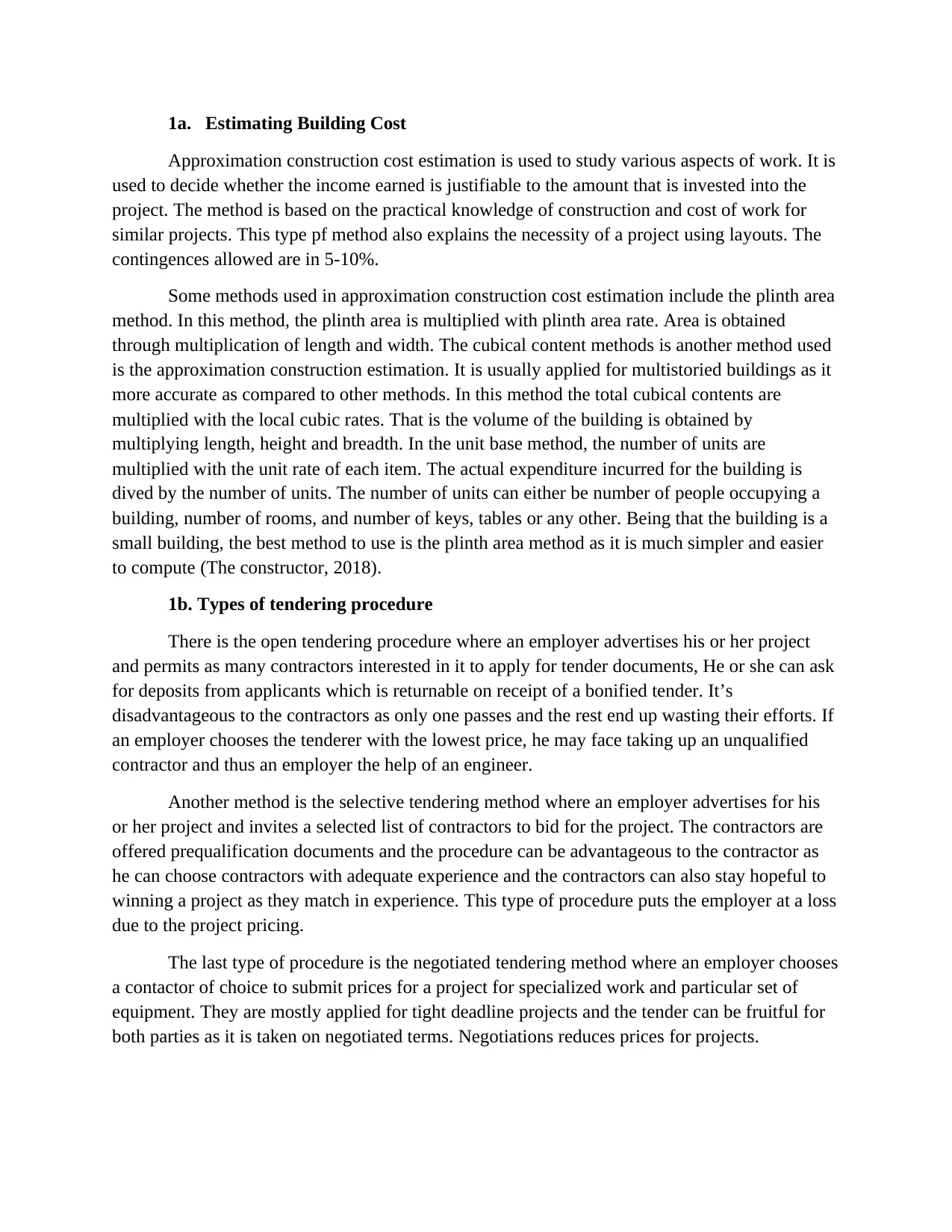
1a. Estimating Building Cost
Approximation construction cost estimation is used to study various aspects of work. It is
used to decide whether the income earned is justifiable to the amount that is invested into the
project. The method is based on the practical knowledge of construction and cost of work for
similar projects. This type pf method also explains the necessity of a project using layouts. The
contingences allowed are in 5-10%.
Some methods used in approximation construction cost estimation include the plinth area
method. In this method, the plinth area is multiplied with plinth area rate. Area is obtained
through multiplication of length and width. The cubical content methods is another method used
is the approximation construction estimation. It is usually applied for multistoried buildings as it
more accurate as compared to other methods. In this method the total cubical contents are
multiplied with the local cubic rates. That is the volume of the building is obtained by
multiplying length, height and breadth. In the unit base method, the number of units are
multiplied with the unit rate of each item. The actual expenditure incurred for the building is
dived by the number of units. The number of units can either be number of people occupying a
building, number of rooms, and number of keys, tables or any other. Being that the building is a
small building, the best method to use is the plinth area method as it is much simpler and easier
to compute (The constructor, 2018).
1b. Types of tendering procedure
There is the open tendering procedure where an employer advertises his or her project
and permits as many contractors interested in it to apply for tender documents, He or she can ask
for deposits from applicants which is returnable on receipt of a bonified tender. It’s
disadvantageous to the contractors as only one passes and the rest end up wasting their efforts. If
an employer chooses the tenderer with the lowest price, he may face taking up an unqualified
contractor and thus an employer the help of an engineer.
Another method is the selective tendering method where an employer advertises for his
or her project and invites a selected list of contractors to bid for the project. The contractors are
offered prequalification documents and the procedure can be advantageous to the contractor as
he can choose contractors with adequate experience and the contractors can also stay hopeful to
winning a project as they match in experience. This type of procedure puts the employer at a loss
due to the project pricing.
The last type of procedure is the negotiated tendering method where an employer chooses
a contactor of choice to submit prices for a project for specialized work and particular set of
equipment. They are mostly applied for tight deadline projects and the tender can be fruitful for
both parties as it is taken on negotiated terms. Negotiations reduces prices for projects.
Approximation construction cost estimation is used to study various aspects of work. It is
used to decide whether the income earned is justifiable to the amount that is invested into the
project. The method is based on the practical knowledge of construction and cost of work for
similar projects. This type pf method also explains the necessity of a project using layouts. The
contingences allowed are in 5-10%.
Some methods used in approximation construction cost estimation include the plinth area
method. In this method, the plinth area is multiplied with plinth area rate. Area is obtained
through multiplication of length and width. The cubical content methods is another method used
is the approximation construction estimation. It is usually applied for multistoried buildings as it
more accurate as compared to other methods. In this method the total cubical contents are
multiplied with the local cubic rates. That is the volume of the building is obtained by
multiplying length, height and breadth. In the unit base method, the number of units are
multiplied with the unit rate of each item. The actual expenditure incurred for the building is
dived by the number of units. The number of units can either be number of people occupying a
building, number of rooms, and number of keys, tables or any other. Being that the building is a
small building, the best method to use is the plinth area method as it is much simpler and easier
to compute (The constructor, 2018).
1b. Types of tendering procedure
There is the open tendering procedure where an employer advertises his or her project
and permits as many contractors interested in it to apply for tender documents, He or she can ask
for deposits from applicants which is returnable on receipt of a bonified tender. It’s
disadvantageous to the contractors as only one passes and the rest end up wasting their efforts. If
an employer chooses the tenderer with the lowest price, he may face taking up an unqualified
contractor and thus an employer the help of an engineer.
Another method is the selective tendering method where an employer advertises for his
or her project and invites a selected list of contractors to bid for the project. The contractors are
offered prequalification documents and the procedure can be advantageous to the contractor as
he can choose contractors with adequate experience and the contractors can also stay hopeful to
winning a project as they match in experience. This type of procedure puts the employer at a loss
due to the project pricing.
The last type of procedure is the negotiated tendering method where an employer chooses
a contactor of choice to submit prices for a project for specialized work and particular set of
equipment. They are mostly applied for tight deadline projects and the tender can be fruitful for
both parties as it is taken on negotiated terms. Negotiations reduces prices for projects.
Paraphrase This Document
Need a fresh take? Get an instant paraphrase of this document with our AI Paraphraser
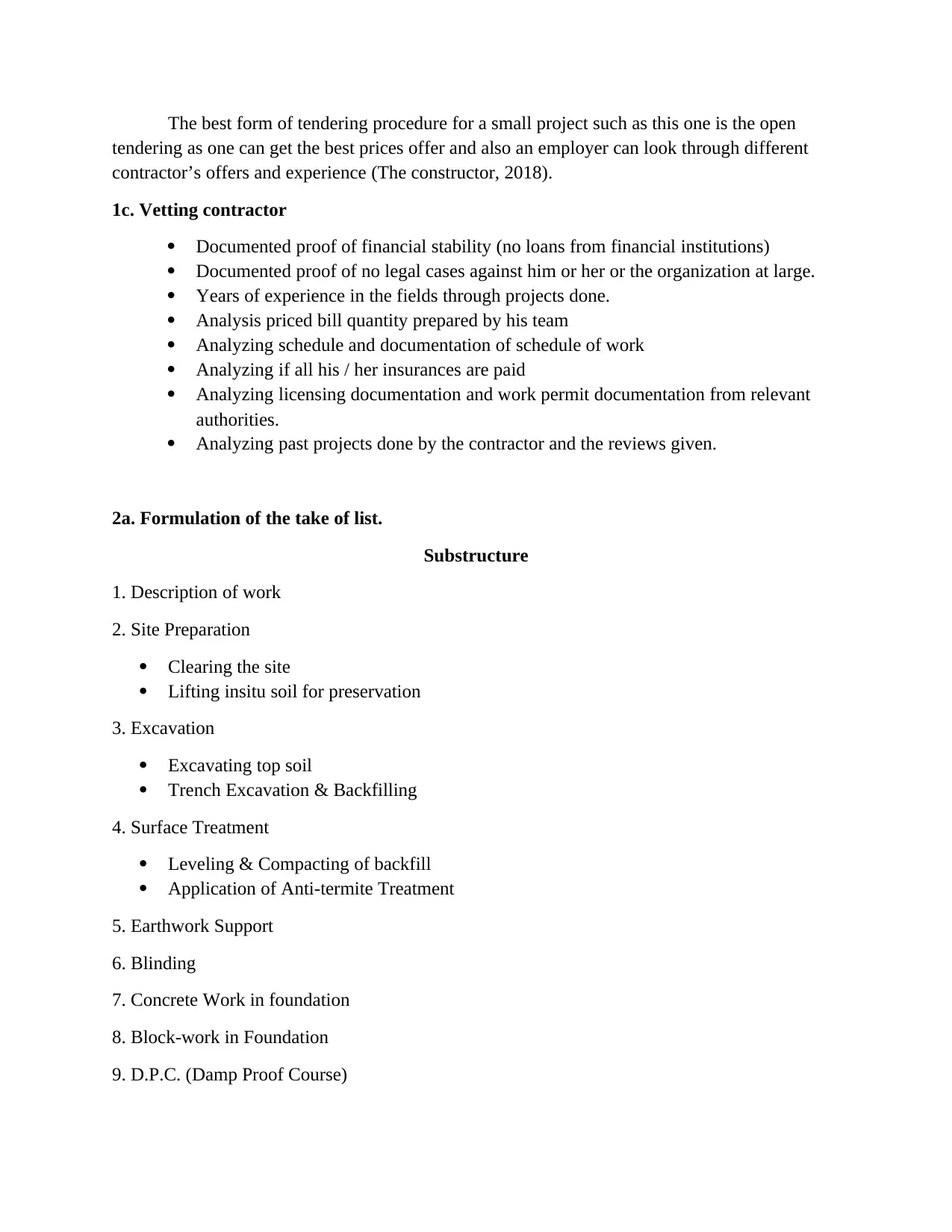
The best form of tendering procedure for a small project such as this one is the open
tendering as one can get the best prices offer and also an employer can look through different
contractor’s offers and experience (The constructor, 2018).
1c. Vetting contractor
Documented proof of financial stability (no loans from financial institutions)
Documented proof of no legal cases against him or her or the organization at large.
Years of experience in the fields through projects done.
Analysis priced bill quantity prepared by his team
Analyzing schedule and documentation of schedule of work
Analyzing if all his / her insurances are paid
Analyzing licensing documentation and work permit documentation from relevant
authorities.
Analyzing past projects done by the contractor and the reviews given.
2a. Formulation of the take of list.
Substructure
1. Description of work
2. Site Preparation
Clearing the site
Lifting insitu soil for preservation
3. Excavation
Excavating top soil
Trench Excavation & Backfilling
4. Surface Treatment
Leveling & Compacting of backfill
Application of Anti-termite Treatment
5. Earthwork Support
6. Blinding
7. Concrete Work in foundation
8. Block-work in Foundation
9. D.P.C. (Damp Proof Course)
tendering as one can get the best prices offer and also an employer can look through different
contractor’s offers and experience (The constructor, 2018).
1c. Vetting contractor
Documented proof of financial stability (no loans from financial institutions)
Documented proof of no legal cases against him or her or the organization at large.
Years of experience in the fields through projects done.
Analysis priced bill quantity prepared by his team
Analyzing schedule and documentation of schedule of work
Analyzing if all his / her insurances are paid
Analyzing licensing documentation and work permit documentation from relevant
authorities.
Analyzing past projects done by the contractor and the reviews given.
2a. Formulation of the take of list.
Substructure
1. Description of work
2. Site Preparation
Clearing the site
Lifting insitu soil for preservation
3. Excavation
Excavating top soil
Trench Excavation & Backfilling
4. Surface Treatment
Leveling & Compacting of backfill
Application of Anti-termite Treatment
5. Earthwork Support
6. Blinding
7. Concrete Work in foundation
8. Block-work in Foundation
9. D.P.C. (Damp Proof Course)
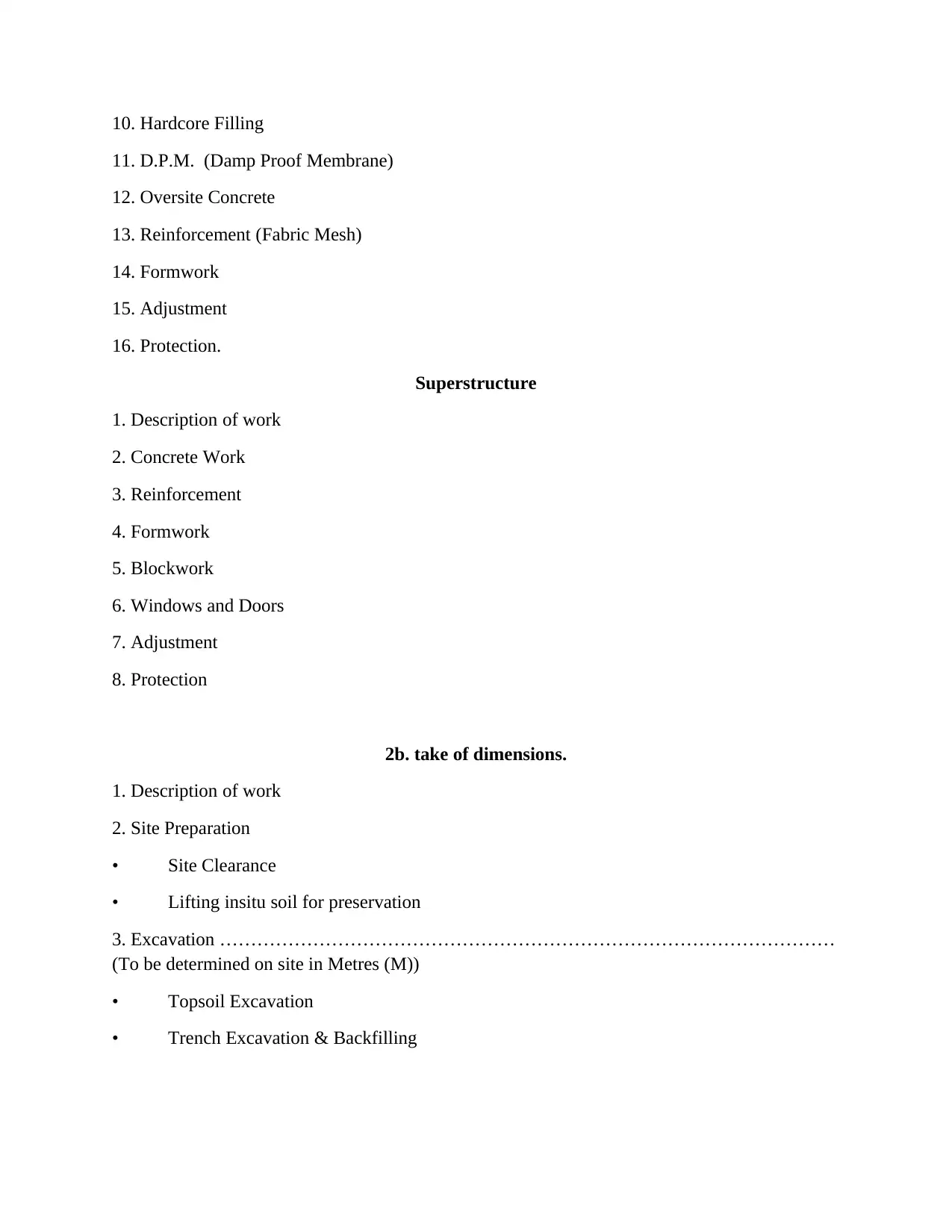
10. Hardcore Filling
11. D.P.M. (Damp Proof Membrane)
12. Oversite Concrete
13. Reinforcement (Fabric Mesh)
14. Formwork
15. Adjustment
16. Protection.
Superstructure
1. Description of work
2. Concrete Work
3. Reinforcement
4. Formwork
5. Blockwork
6. Windows and Doors
7. Adjustment
8. Protection
2b. take of dimensions.
1. Description of work
2. Site Preparation
• Site Clearance
• Lifting insitu soil for preservation
3. Excavation ………………………………………………………………………………………
(To be determined on site in Metres (M))
• Topsoil Excavation
• Trench Excavation & Backfilling
11. D.P.M. (Damp Proof Membrane)
12. Oversite Concrete
13. Reinforcement (Fabric Mesh)
14. Formwork
15. Adjustment
16. Protection.
Superstructure
1. Description of work
2. Concrete Work
3. Reinforcement
4. Formwork
5. Blockwork
6. Windows and Doors
7. Adjustment
8. Protection
2b. take of dimensions.
1. Description of work
2. Site Preparation
• Site Clearance
• Lifting insitu soil for preservation
3. Excavation ………………………………………………………………………………………
(To be determined on site in Metres (M))
• Topsoil Excavation
• Trench Excavation & Backfilling
⊘ This is a preview!⊘
Do you want full access?
Subscribe today to unlock all pages.

Trusted by 1+ million students worldwide
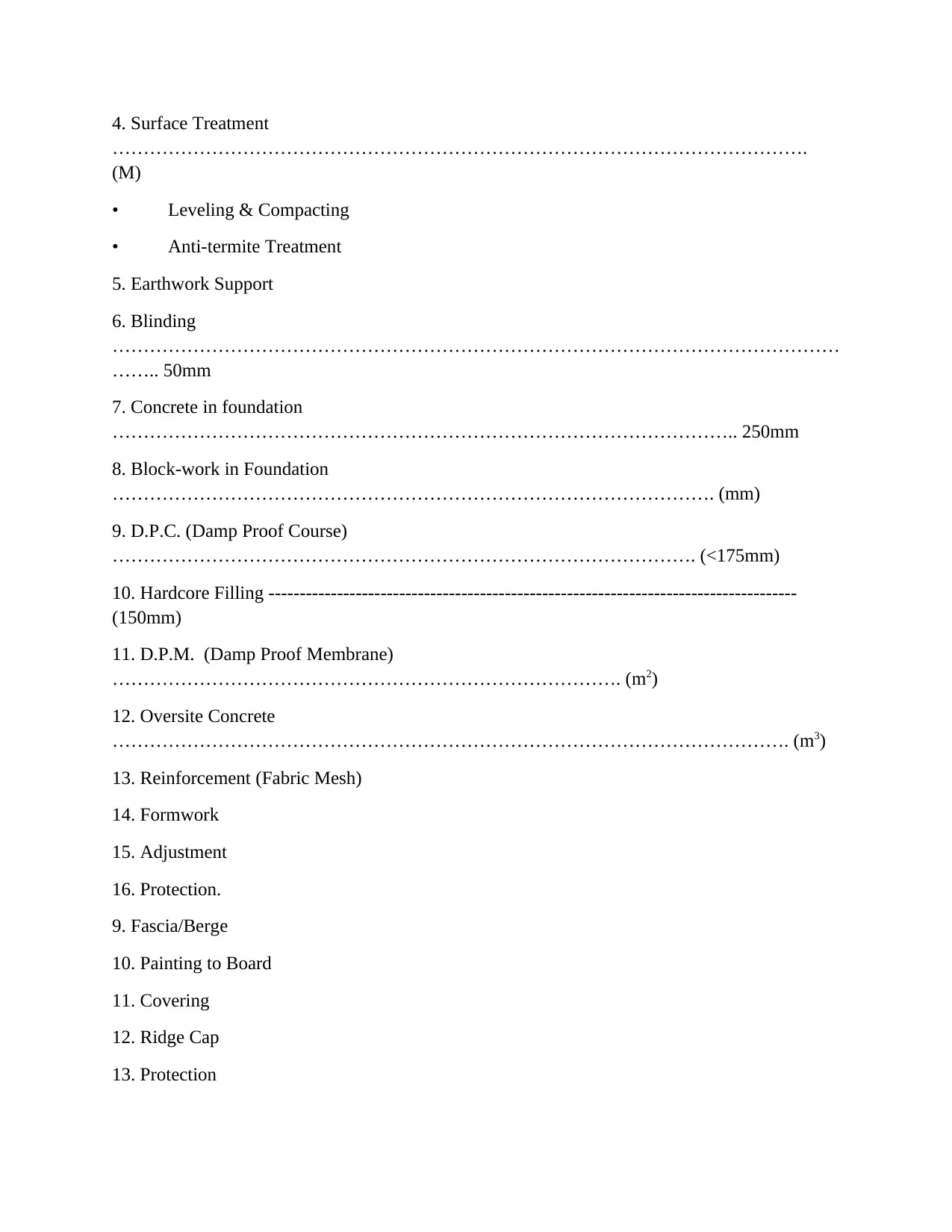
4. Surface Treatment
………………………………………………………………………………………………….
(M)
• Leveling & Compacting
• Anti-termite Treatment
5. Earthwork Support
6. Blinding
………………………………………………………………………………………………………
…….. 50mm
7. Concrete in foundation
……………………………………………………………………………………….. 250mm
8. Block-work in Foundation
……………………………………………………………………………………. (mm)
9. D.P.C. (Damp Proof Course)
…………………………………………………………………………………. (<175mm)
10. Hardcore Filling -------------------------------------------------------------------------------------
(150mm)
11. D.P.M. (Damp Proof Membrane)
………………………………………………………………………. (m2)
12. Oversite Concrete
………………………………………………………………………………………………. (m3)
13. Reinforcement (Fabric Mesh)
14. Formwork
15. Adjustment
16. Protection.
9. Fascia/Berge
10. Painting to Board
11. Covering
12. Ridge Cap
13. Protection
………………………………………………………………………………………………….
(M)
• Leveling & Compacting
• Anti-termite Treatment
5. Earthwork Support
6. Blinding
………………………………………………………………………………………………………
…….. 50mm
7. Concrete in foundation
……………………………………………………………………………………….. 250mm
8. Block-work in Foundation
……………………………………………………………………………………. (mm)
9. D.P.C. (Damp Proof Course)
…………………………………………………………………………………. (<175mm)
10. Hardcore Filling -------------------------------------------------------------------------------------
(150mm)
11. D.P.M. (Damp Proof Membrane)
………………………………………………………………………. (m2)
12. Oversite Concrete
………………………………………………………………………………………………. (m3)
13. Reinforcement (Fabric Mesh)
14. Formwork
15. Adjustment
16. Protection.
9. Fascia/Berge
10. Painting to Board
11. Covering
12. Ridge Cap
13. Protection
Paraphrase This Document
Need a fresh take? Get an instant paraphrase of this document with our AI Paraphraser
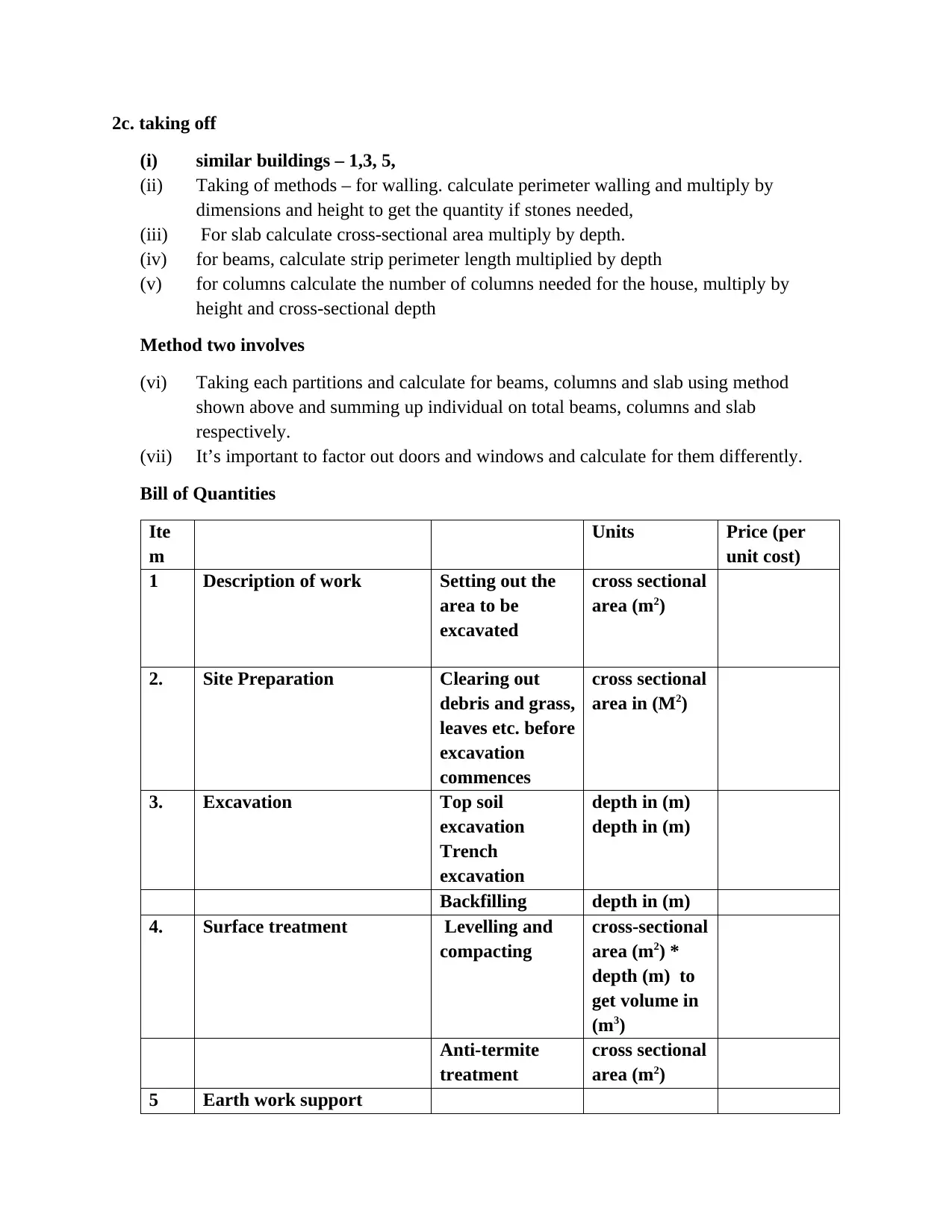
2c. taking off
(i) similar buildings – 1,3, 5,
(ii) Taking of methods – for walling. calculate perimeter walling and multiply by
dimensions and height to get the quantity if stones needed,
(iii) For slab calculate cross-sectional area multiply by depth.
(iv) for beams, calculate strip perimeter length multiplied by depth
(v) for columns calculate the number of columns needed for the house, multiply by
height and cross-sectional depth
Method two involves
(vi) Taking each partitions and calculate for beams, columns and slab using method
shown above and summing up individual on total beams, columns and slab
respectively.
(vii) It’s important to factor out doors and windows and calculate for them differently.
Bill of Quantities
Ite
m
Units Price (per
unit cost)
1 Description of work Setting out the
area to be
excavated
cross sectional
area (m2)
2. Site Preparation Clearing out
debris and grass,
leaves etc. before
excavation
commences
cross sectional
area in (M2)
3. Excavation Top soil
excavation
Trench
excavation
depth in (m)
depth in (m)
Backfilling depth in (m)
4. Surface treatment Levelling and
compacting
cross-sectional
area (m2) *
depth (m) to
get volume in
(m3)
Anti-termite
treatment
cross sectional
area (m2)
5 Earth work support
(i) similar buildings – 1,3, 5,
(ii) Taking of methods – for walling. calculate perimeter walling and multiply by
dimensions and height to get the quantity if stones needed,
(iii) For slab calculate cross-sectional area multiply by depth.
(iv) for beams, calculate strip perimeter length multiplied by depth
(v) for columns calculate the number of columns needed for the house, multiply by
height and cross-sectional depth
Method two involves
(vi) Taking each partitions and calculate for beams, columns and slab using method
shown above and summing up individual on total beams, columns and slab
respectively.
(vii) It’s important to factor out doors and windows and calculate for them differently.
Bill of Quantities
Ite
m
Units Price (per
unit cost)
1 Description of work Setting out the
area to be
excavated
cross sectional
area (m2)
2. Site Preparation Clearing out
debris and grass,
leaves etc. before
excavation
commences
cross sectional
area in (M2)
3. Excavation Top soil
excavation
Trench
excavation
depth in (m)
depth in (m)
Backfilling depth in (m)
4. Surface treatment Levelling and
compacting
cross-sectional
area (m2) *
depth (m) to
get volume in
(m3)
Anti-termite
treatment
cross sectional
area (m2)
5 Earth work support
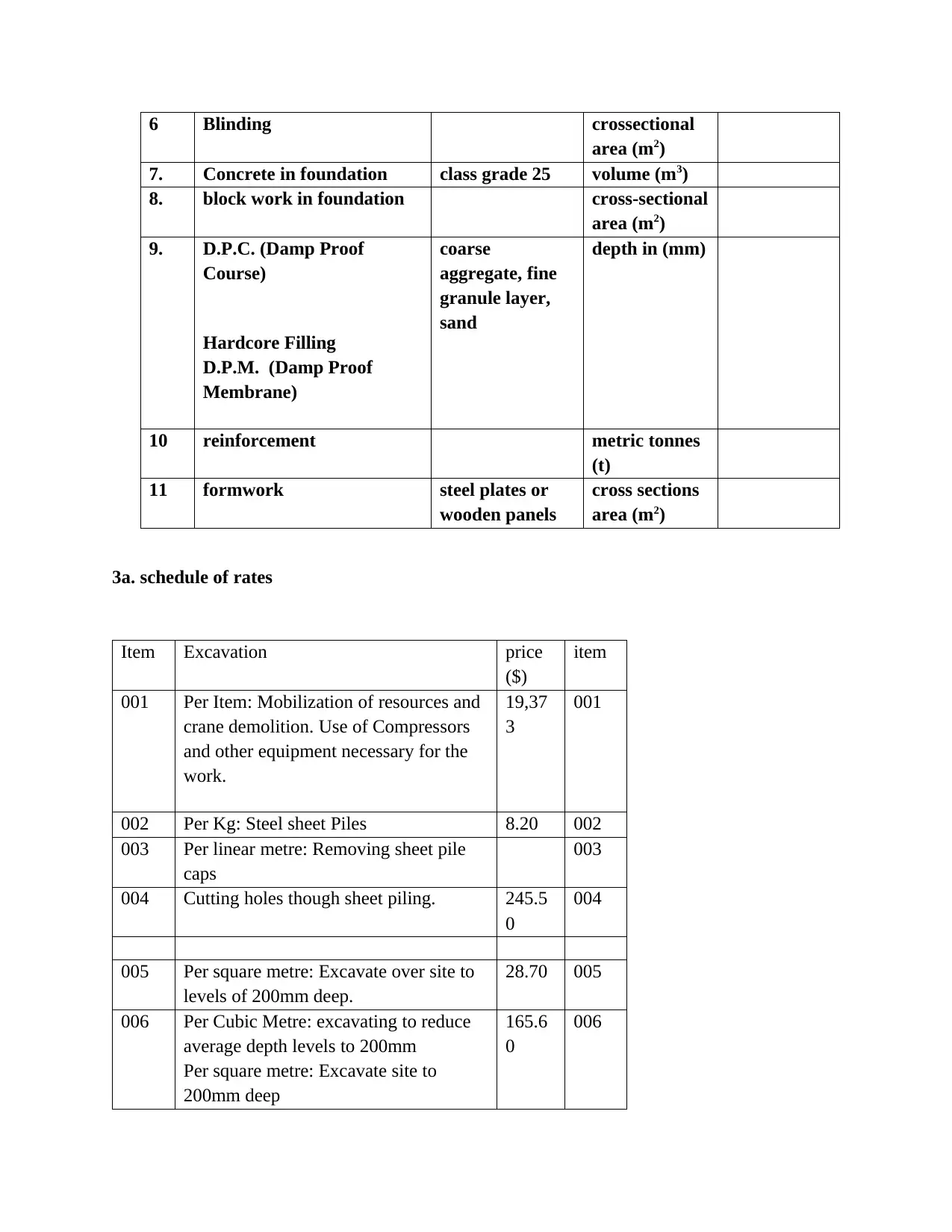
6 Blinding crossectional
area (m2)
7. Concrete in foundation class grade 25 volume (m3)
8. block work in foundation cross-sectional
area (m2)
9. D.P.C. (Damp Proof
Course)
Hardcore Filling
D.P.M. (Damp Proof
Membrane)
coarse
aggregate, fine
granule layer,
sand
depth in (mm)
10 reinforcement metric tonnes
(t)
11 formwork steel plates or
wooden panels
cross sections
area (m2)
3a. schedule of rates
Item Excavation price
($)
item
001 Per Item: Mobilization of resources and
crane demolition. Use of Compressors
and other equipment necessary for the
work.
19,37
3
001
002 Per Kg: Steel sheet Piles 8.20 002
003 Per linear metre: Removing sheet pile
caps
003
004 Cutting holes though sheet piling. 245.5
0
004
005 Per square metre: Excavate over site to
levels of 200mm deep.
28.70 005
006 Per Cubic Metre: excavating to reduce
average depth levels to 200mm
Per square metre: Excavate site to
200mm deep
165.6
0
006
area (m2)
7. Concrete in foundation class grade 25 volume (m3)
8. block work in foundation cross-sectional
area (m2)
9. D.P.C. (Damp Proof
Course)
Hardcore Filling
D.P.M. (Damp Proof
Membrane)
coarse
aggregate, fine
granule layer,
sand
depth in (mm)
10 reinforcement metric tonnes
(t)
11 formwork steel plates or
wooden panels
cross sections
area (m2)
3a. schedule of rates
Item Excavation price
($)
item
001 Per Item: Mobilization of resources and
crane demolition. Use of Compressors
and other equipment necessary for the
work.
19,37
3
001
002 Per Kg: Steel sheet Piles 8.20 002
003 Per linear metre: Removing sheet pile
caps
003
004 Cutting holes though sheet piling. 245.5
0
004
005 Per square metre: Excavate over site to
levels of 200mm deep.
28.70 005
006 Per Cubic Metre: excavating to reduce
average depth levels to 200mm
Per square metre: Excavate site to
200mm deep
165.6
0
006
⊘ This is a preview!⊘
Do you want full access?
Subscribe today to unlock all pages.

Trusted by 1+ million students worldwide
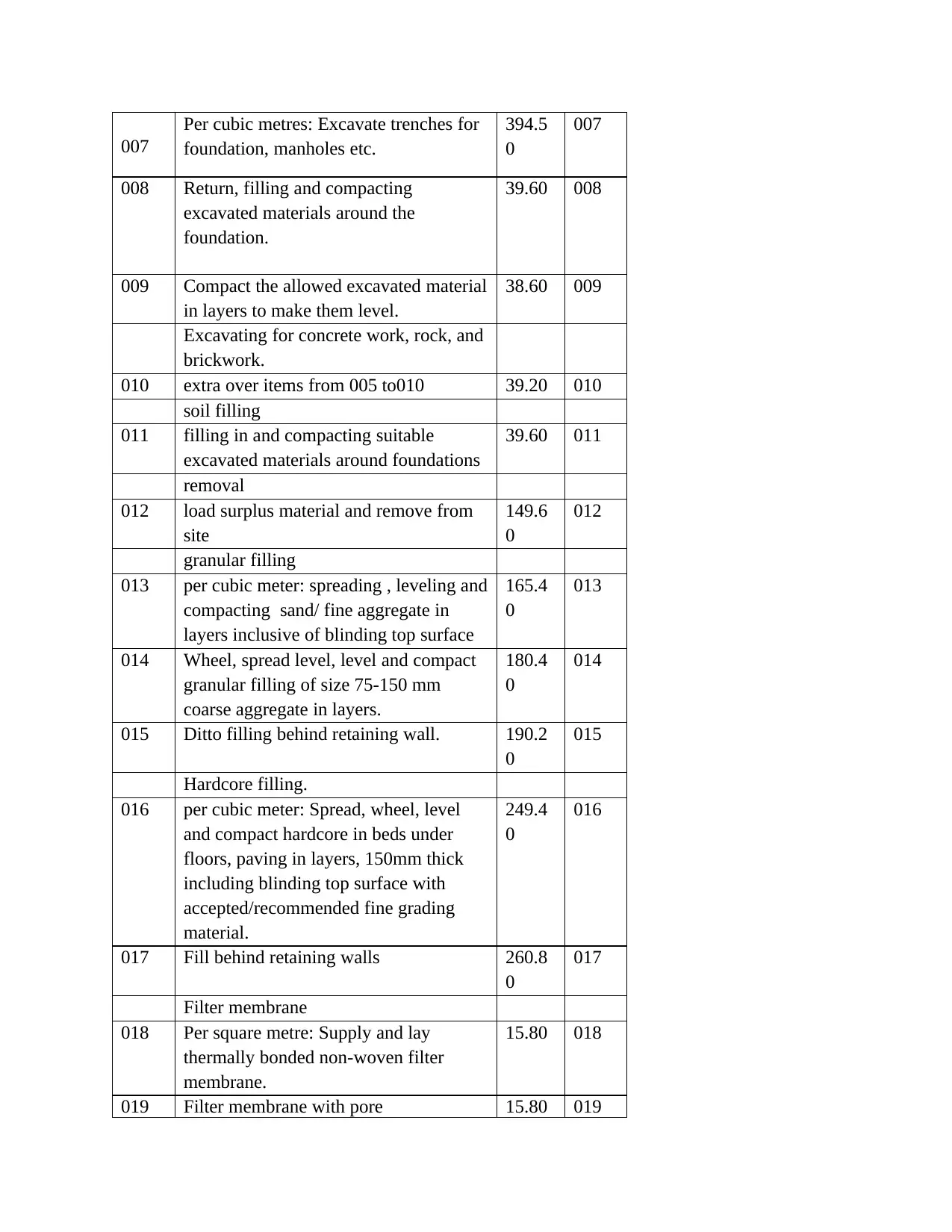
007
Per cubic metres: Excavate trenches for
foundation, manholes etc.
394.5
0
007
008 Return, filling and compacting
excavated materials around the
foundation.
39.60 008
009 Compact the allowed excavated material
in layers to make them level.
38.60 009
Excavating for concrete work, rock, and
brickwork.
010 extra over items from 005 to010 39.20 010
soil filling
011 filling in and compacting suitable
excavated materials around foundations
39.60 011
removal
012 load surplus material and remove from
site
149.6
0
012
granular filling
013 per cubic meter: spreading , leveling and
compacting sand/ fine aggregate in
layers inclusive of blinding top surface
165.4
0
013
014 Wheel, spread level, level and compact
granular filling of size 75-150 mm
coarse aggregate in layers.
180.4
0
014
015 Ditto filling behind retaining wall. 190.2
0
015
Hardcore filling.
016 per cubic meter: Spread, wheel, level
and compact hardcore in beds under
floors, paving in layers, 150mm thick
including blinding top surface with
accepted/recommended fine grading
material.
249.4
0
016
017 Fill behind retaining walls 260.8
0
017
Filter membrane
018 Per square metre: Supply and lay
thermally bonded non-woven filter
membrane.
15.80 018
019 Filter membrane with pore 15.80 019
Per cubic metres: Excavate trenches for
foundation, manholes etc.
394.5
0
007
008 Return, filling and compacting
excavated materials around the
foundation.
39.60 008
009 Compact the allowed excavated material
in layers to make them level.
38.60 009
Excavating for concrete work, rock, and
brickwork.
010 extra over items from 005 to010 39.20 010
soil filling
011 filling in and compacting suitable
excavated materials around foundations
39.60 011
removal
012 load surplus material and remove from
site
149.6
0
012
granular filling
013 per cubic meter: spreading , leveling and
compacting sand/ fine aggregate in
layers inclusive of blinding top surface
165.4
0
013
014 Wheel, spread level, level and compact
granular filling of size 75-150 mm
coarse aggregate in layers.
180.4
0
014
015 Ditto filling behind retaining wall. 190.2
0
015
Hardcore filling.
016 per cubic meter: Spread, wheel, level
and compact hardcore in beds under
floors, paving in layers, 150mm thick
including blinding top surface with
accepted/recommended fine grading
material.
249.4
0
016
017 Fill behind retaining walls 260.8
0
017
Filter membrane
018 Per square metre: Supply and lay
thermally bonded non-woven filter
membrane.
15.80 018
019 Filter membrane with pore 15.80 019
Paraphrase This Document
Need a fresh take? Get an instant paraphrase of this document with our AI Paraphraser
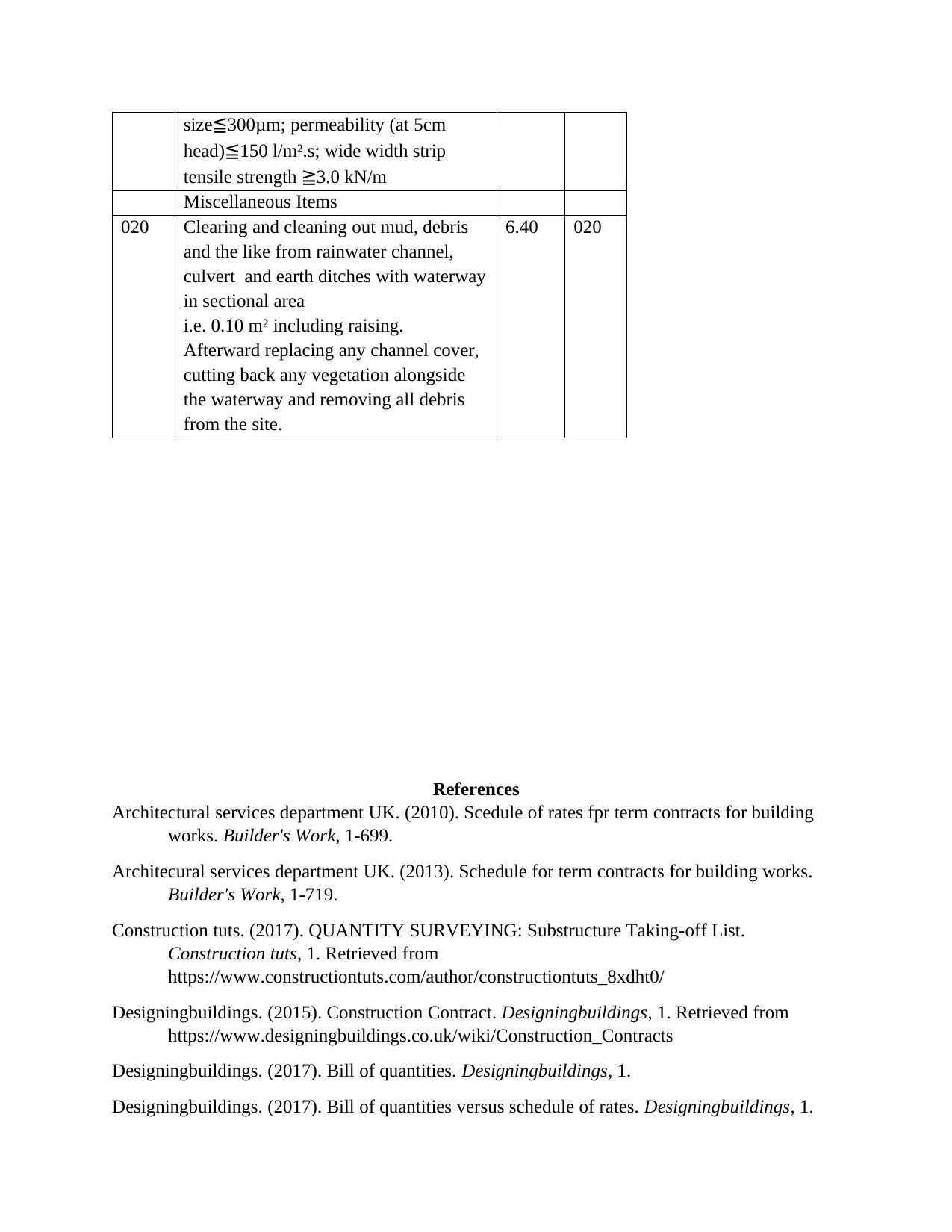
size≦300μm; permeability (at 5cm
head)≦150 l/m².s; wide width strip
tensile strength ≧3.0 kN/m
Miscellaneous Items
020 Clearing and cleaning out mud, debris
and the like from rainwater channel,
culvert and earth ditches with waterway
in sectional area
i.e. 0.10 m² including raising.
Afterward replacing any channel cover,
cutting back any vegetation alongside
the waterway and removing all debris
from the site.
6.40 020
References
Architectural services department UK. (2010). Scedule of rates fpr term contracts for building
works. Builder's Work, 1-699.
Architecural services department UK. (2013). Schedule for term contracts for building works.
Builder's Work, 1-719.
Construction tuts. (2017). QUANTITY SURVEYING: Substructure Taking-off List.
Construction tuts, 1. Retrieved from
https://www.constructiontuts.com/author/constructiontuts_8xdht0/
Designingbuildings. (2015). Construction Contract. Designingbuildings, 1. Retrieved from
https://www.designingbuildings.co.uk/wiki/Construction_Contracts
Designingbuildings. (2017). Bill of quantities. Designingbuildings, 1.
Designingbuildings. (2017). Bill of quantities versus schedule of rates. Designingbuildings, 1.
head)≦150 l/m².s; wide width strip
tensile strength ≧3.0 kN/m
Miscellaneous Items
020 Clearing and cleaning out mud, debris
and the like from rainwater channel,
culvert and earth ditches with waterway
in sectional area
i.e. 0.10 m² including raising.
Afterward replacing any channel cover,
cutting back any vegetation alongside
the waterway and removing all debris
from the site.
6.40 020
References
Architectural services department UK. (2010). Scedule of rates fpr term contracts for building
works. Builder's Work, 1-699.
Architecural services department UK. (2013). Schedule for term contracts for building works.
Builder's Work, 1-719.
Construction tuts. (2017). QUANTITY SURVEYING: Substructure Taking-off List.
Construction tuts, 1. Retrieved from
https://www.constructiontuts.com/author/constructiontuts_8xdht0/
Designingbuildings. (2015). Construction Contract. Designingbuildings, 1. Retrieved from
https://www.designingbuildings.co.uk/wiki/Construction_Contracts
Designingbuildings. (2017). Bill of quantities. Designingbuildings, 1.
Designingbuildings. (2017). Bill of quantities versus schedule of rates. Designingbuildings, 1.
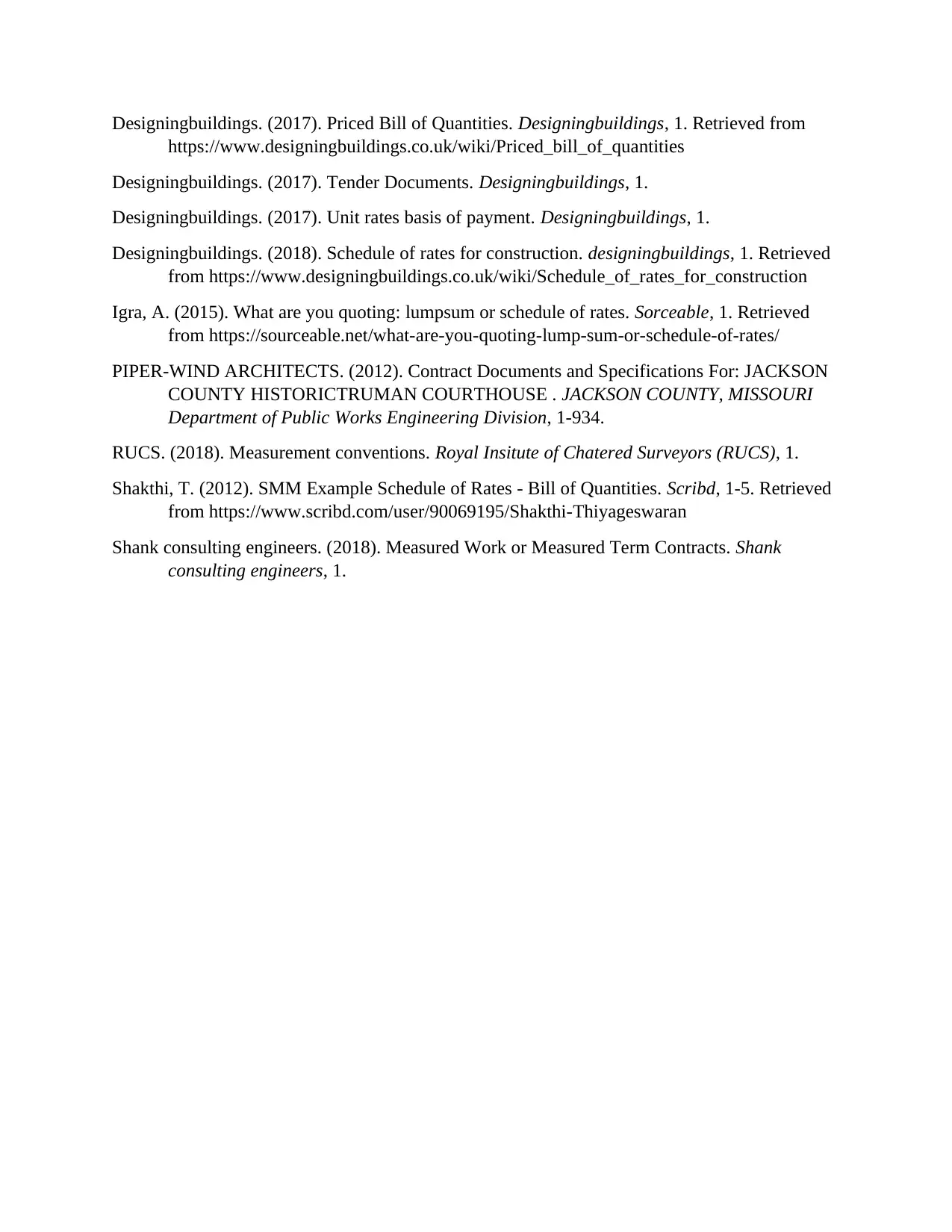
Designingbuildings. (2017). Priced Bill of Quantities. Designingbuildings, 1. Retrieved from
https://www.designingbuildings.co.uk/wiki/Priced_bill_of_quantities
Designingbuildings. (2017). Tender Documents. Designingbuildings, 1.
Designingbuildings. (2017). Unit rates basis of payment. Designingbuildings, 1.
Designingbuildings. (2018). Schedule of rates for construction. designingbuildings, 1. Retrieved
from https://www.designingbuildings.co.uk/wiki/Schedule_of_rates_for_construction
Igra, A. (2015). What are you quoting: lumpsum or schedule of rates. Sorceable, 1. Retrieved
from https://sourceable.net/what-are-you-quoting-lump-sum-or-schedule-of-rates/
PIPER-WIND ARCHITECTS. (2012). Contract Documents and Specifications For: JACKSON
COUNTY HISTORICTRUMAN COURTHOUSE . JACKSON COUNTY, MISSOURI
Department of Public Works Engineering Division, 1-934.
RUCS. (2018). Measurement conventions. Royal Insitute of Chatered Surveyors (RUCS), 1.
Shakthi, T. (2012). SMM Example Schedule of Rates - Bill of Quantities. Scribd, 1-5. Retrieved
from https://www.scribd.com/user/90069195/Shakthi-Thiyageswaran
Shank consulting engineers. (2018). Measured Work or Measured Term Contracts. Shank
consulting engineers, 1.
https://www.designingbuildings.co.uk/wiki/Priced_bill_of_quantities
Designingbuildings. (2017). Tender Documents. Designingbuildings, 1.
Designingbuildings. (2017). Unit rates basis of payment. Designingbuildings, 1.
Designingbuildings. (2018). Schedule of rates for construction. designingbuildings, 1. Retrieved
from https://www.designingbuildings.co.uk/wiki/Schedule_of_rates_for_construction
Igra, A. (2015). What are you quoting: lumpsum or schedule of rates. Sorceable, 1. Retrieved
from https://sourceable.net/what-are-you-quoting-lump-sum-or-schedule-of-rates/
PIPER-WIND ARCHITECTS. (2012). Contract Documents and Specifications For: JACKSON
COUNTY HISTORICTRUMAN COURTHOUSE . JACKSON COUNTY, MISSOURI
Department of Public Works Engineering Division, 1-934.
RUCS. (2018). Measurement conventions. Royal Insitute of Chatered Surveyors (RUCS), 1.
Shakthi, T. (2012). SMM Example Schedule of Rates - Bill of Quantities. Scribd, 1-5. Retrieved
from https://www.scribd.com/user/90069195/Shakthi-Thiyageswaran
Shank consulting engineers. (2018). Measured Work or Measured Term Contracts. Shank
consulting engineers, 1.
⊘ This is a preview!⊘
Do you want full access?
Subscribe today to unlock all pages.

Trusted by 1+ million students worldwide
1 out of 9
Related Documents
Your All-in-One AI-Powered Toolkit for Academic Success.
+13062052269
info@desklib.com
Available 24*7 on WhatsApp / Email
![[object Object]](/_next/static/media/star-bottom.7253800d.svg)
Unlock your academic potential
Copyright © 2020–2025 A2Z Services. All Rights Reserved. Developed and managed by ZUCOL.





